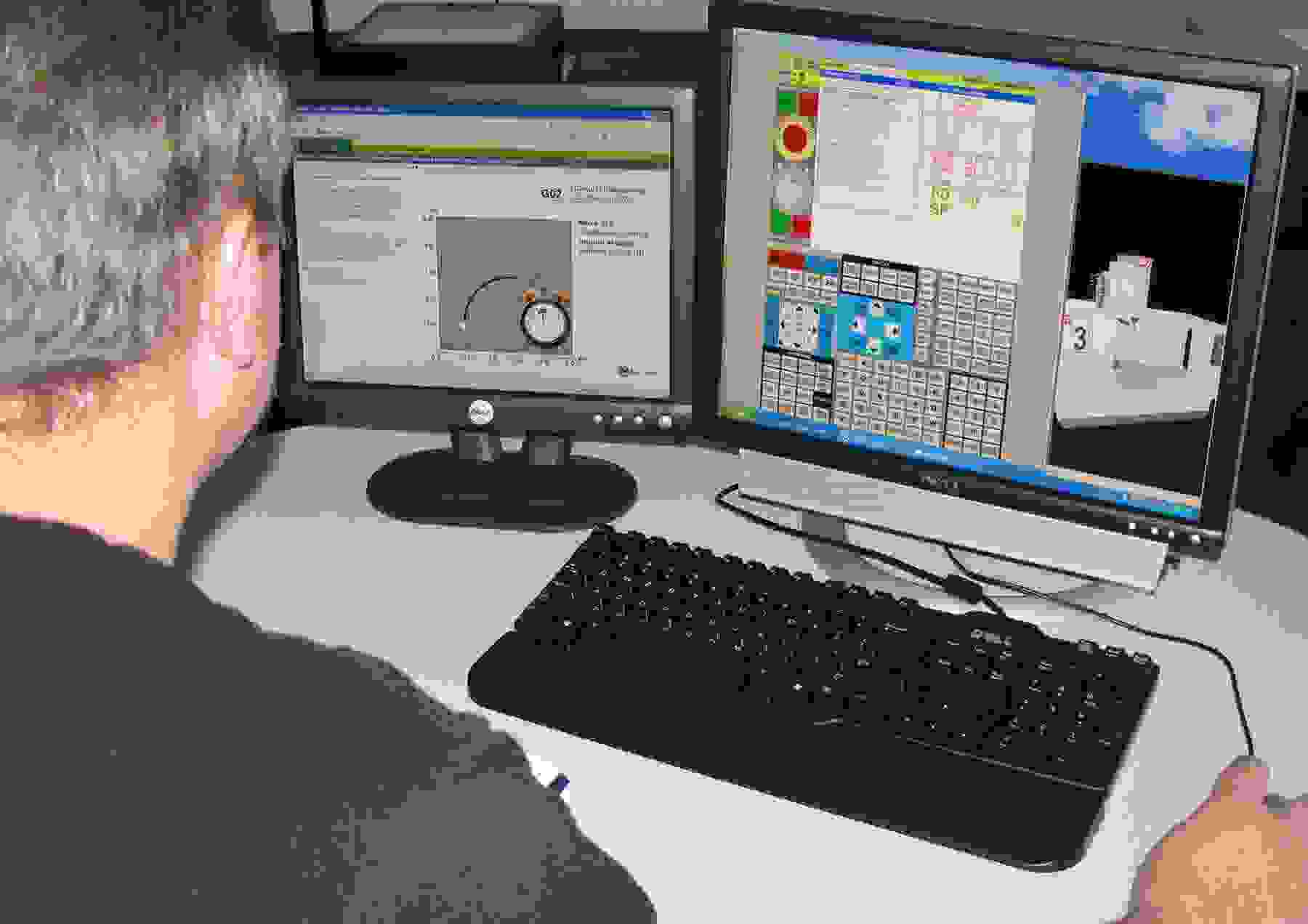When NMC purchased a mill and lathe from Haas Automation, it licensed VTE-CNC, which consists of software with tutorials and quizzes; and the virtual CNC panels and 3D machining centers that aide in teaching machine tool operation. Now, students can access class materials 24/7 online at home or in NMC’s computer lab. They learn at their own pace—and can back up to repeat material as much as needed.

Instructors and students benefit from online interactive learning content, exercises, assessments and virtual CNC panels and 3D machines that run actual M&G code programs.
Teaching software can be a powerful tool when it’s used to reinforce classroom instruction— and it helps to make everything more efficient. The Virtual Training Environment for CNC (VTE-CNC) has vivid, easily understood graphical demonstrations of tool movement. The software includes self-tests with immediate feedback that helps students come to class better prepared.Â
Niergarth’s classroom presentations reinforce what students get from VTE-CNC. “Different people have different ways that they learn better,†he states. The combination of VTE-CNC and classroom instruction ensures that the college is providing the most comprehensive learning environment available today.
In just over a year, the Virtual Training Environment for CNC (VTE-CNC), powered by Immerse2Learn.com has made the Manufacturing Technology program more efficient and effective at Northwestern Michigan College (NMC) in Traverse City. Ray Niergarth, Instructor in Manufacturing Technology, credits VTE-CNC online accessibility and interactive features. Northwestern Michigan College’s (NMC) Manufacturing Technology program comprises basic mill and lathe operations (two semesters) and CNC machining and CAM programming (two semesters). Graduates can earn a Machining Certificate or an Associate Degree.
Students Work Smarter
NMC uses VTE-CNC to teach actual CNC operations in the virtual world, so that students work smarter in the real-world. Niergarth says, “Students develop CNC programming and setup skills in VTE-CNC, before they are able to work one-on-one with instructors at actual CNC machines on the shop floor.†Niergarth adds, “This training process helps make the learning experience more productive.â€
With VTE-CNC, the learning material is “always the same for each class, for each student,†he continues. “There’s always a chance that something gets overlooked or presented a little differently in the classroom. The software gives everyone the same information and it’s always easy to find there.â€
Bottom Line—everyone works smarter. Classroom instruction and software reinforce each other, so students learn more and learn it quicker. Instructors make better use of classroom time and present more material in the same number of hours.
Like the Real Thing
Niergarth has one Haas lathe and one Haas mill in his classroom, which means that he can supervise only two students as they work hands-on. While they wait their turn, other students complete assignments with VTE-CNC’s virtual CNC panels and 3D machining centers with graphic imagery that looks and behaves like the real thing. Niergarth says that it’s important to instruct students on the machine one by one to ensure safety and also because he can give them tips from his personal
experience. If he wants to demonstrate an operation to the entire class, he can project VTE-CNC virtual CNC panels and Machines at the front of the classroom. Students
interactively follow along at their own computer stations. This beats having everyone crowd
around the machine.
Students learn CNC programming in VTE-CNC’s Internet-based virtual environment, troubleshooting as they go. The virtual CNC panel sounds an alarm if they make an error that would crash a real machine. This saves time and all but eliminates the risk of costly
machine crashes. “We catch a lot of potential problems,†says Niergarth.Â
There are other VTE-CNC features that Niergarth likes. He can customize or edit test questions in the material to fit the learning style of students or his personal preference.
“The instructor editing capability is definitely a benefit,†he says. The instructor’s automatic grade book/student performance tracking feature speeds and simplifies record keeping for large classes, freeing Niergarth to teach.
To continually promote NMC’s Manufacturing Technology program, Niergarth creates awareness among high school counselors with presentations and tours to manufacturing sites. He tells them that machining has changed over the past few years with increasingly sophisticated technology and a
highly trained workforce.Â
NMC shares its machine lab and equipment with the high school machine shop program. Younger students learn CNC operation and setup. CNC Programming starts when they reach college level. VTE-CNC helps here too. The software is wonderfully flexible, which allows instructors to make selected portions available to beginning students.Â
Industry calls NMC looking for graduates. As Niergarth tells it, auto-related manufacturing in Michigan is “slowing down or closing,†but other area manufacturers are “going strongâ€Â with products like stainless surgical instruments. There are plenty of openings and opportunities for graduates in northwestern Michigan’s growing manufacturing sector.Â
Niergarth sees VTE-CNC as the coming thing. “There will probably be a lot more programs that benefit from this technology,†he states. It could be used to teach “computer-assisted drafting, solid modeling, programming logic controllers, and many other skilled trades.â€




Comments ( 4,550 )